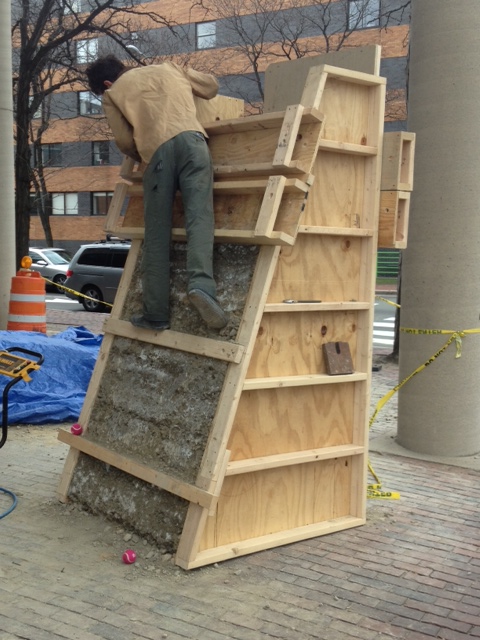This weekend F+ was roaming through the streets of Boston to check out Harvard’s Mud Hall rammed earth project outside of the GSD’s Gund Hall. The instillation is showing off the age old practice of rammed earth for building construction and as a way to challenge today’s ideas about “Green Design” practices. Make sure to follow at mudhall.wordpress.com, as we will be making sure F+ is back to check it out at completion.
SCHOOL: Harvard GSD
PROJECT: http://mudhall.wordpress.com/
LOCATION: Gund Hall
YEAR: 2012
“Mud Hall is a project initiated by Harvard University’s 2012 Loeb Fellows to promote awareness about rammed earth construction and to challenge conventional thinking about green building. Raw earth is the most plentiful and sustainable building material on the planet, yet architects rarely incorporate it into their designs.
To demonstrate the potential of mud and clay for everyday buildings, the Loeb Fellows are enlisting 25 students at Harvard’s Graduate School of Design to construct a rammed earth structure at the entrance to the school’s celebrated Gund Hall. Mud Hall is meant to offer an alternative to the current orthodoxy about sustainable construction. This blog will chronicle the evolution of the Mud Hall project, and offer detailed information about the rammed earth process.
While the students worked out designs, three experts in rammed earth construction circled the room to offer guidance. Mud Hall’s construction is being overseen by Loeb Fellows Anna Heringer and Chris Calott and the Austrian earthworks artist Martin Rauch. All have fashioned elegant, modern buildings out of nothing more than mud and water. (They’ll be getting technical help from the GSD’s Mark Mulligan, Dan Borelli, Jane Hutton and Jurg Conzett. As well as guidance from Loeb FellowsInga Saffron, Ian Lockwood, Jean Brownhill Lauer and Peter Park) Anna, who learned the craft in Bangladesh, gained international acclaim after completing a school in Rudrapur.
All the Loeb Fellows were impressed by Anna’s passion for what she likes to call mud construction. Because earth and water can be found everywhere, she believes earthern construction is the most sustainable way to build. At some point this fall, the Loeb Fellows jokingly suggested that they should build a mud structure as a counterpoint to the GSD’s Gund Hall – a building constructed of less-than-sustainable concrete. The casual idea quickly took on a life of its own, and the fellowship administrators, Jim Stockard and Sally Young, encouraged the Loebs to put together a serious proposal. GSD Dean Mohsen Mostafavi gave Mud Hall preliminary approval almost immediately.
During the first hours of Saturday’s charette, there was a lot of trial and error as students explored the possibilities of rammed earth. Mud is an incredibly pliable, sculptural material and many participants couldn’t help channeling their inner Richard Serra – turning out miniature sculptures in gray clay. Anna and Chris had to gently remind the group that structure should be simple, so it can be built quickly and cheaply.”
All Text via mudhall.wordpress.com









Pingback: Readying MudWorks for the Limelight « Mud Hall
Pingback: